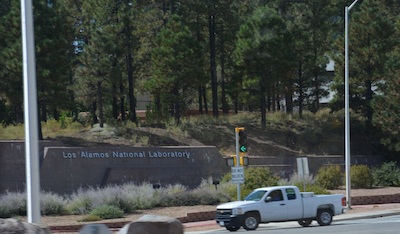 Back in the days of the Manhattan Project, Los Alamos National Laboratory (LANL) was a secret to the outside world. Founded to develop technologies to defend America, that mission is still in place today. During the Verdesian Los Alamos Media Tour, ag reporters had the opportunity to learn about the work being done at LANL as well as how some of the innovations developed in the lab eventually end up on a farmer’s field. I should note that the scientific foundation of Verdesian’s Take-Off product was developed at LANL.
Back in the days of the Manhattan Project, Los Alamos National Laboratory (LANL) was a secret to the outside world. Founded to develop technologies to defend America, that mission is still in place today. During the Verdesian Los Alamos Media Tour, ag reporters had the opportunity to learn about the work being done at LANL as well as how some of the innovations developed in the lab eventually end up on a farmer’s field. I should note that the scientific foundation of Verdesian’s Take-Off product was developed at LANL.
Duncan McBranch is the chief technology officer for LANL and he said the lab’s mission focuses on four scientific pillars:
- Nuclear and particular futures: this pillar is composed of four major areas: nuclear, particle astrophysics and cosmology (NPAC), applied nuclear science and engineering, high energy density plasmas and fluids and accelerators and electrodynamics.
- Materials for the Future: the visions of this pillar are performance, how a material fulfills the defined requirements, and functionality, or the actual design and tailoring of a material to perform beyond the traditional performance.
- Information and Science Technology: this pillar addresses emerging challenges in national security, societal prosperity and fundamental science.
- Science of Signatures: the strategy of this pillar is to discover new signatures, revolutionize the measurement of signatures and engineer and deploy advanced signature-related technologies. Signatures are used to characterize measures, signals, and properties in or of complex systems to detect or attribute change; predict systems behavior across scales in space (subatomic to astronomic) and time (femtosecond to geologic); and assess impacts to the system of change.
By now you are thinking no really, what does LANL do that relates to agriculture. For example, the lab is using some of its technology to better understand citrus greening and eventually work with a private sector company to develop and license a solution to the disease.
Duncan noted that biologics are fundamental to the science of the century. “Bioinformatics are driving frontier issues for the lab and we must be active in this frontier,” stressed Duncan.
One other critical area of work the lab is currently working on is preventing horrific viruses such as ebola. In this country he said we don’t have much of a threat today, but they are doing a lot of research on understanding pathogens and diseases and designing medical countermeasures. Eventually what is discovered here can be used to better understand viruses in our food supply – as food security is one of the top areas of concern under LANL’s scientific pillars.
Listen to Duncan McBranch’s overview of LANL here: Remarks from Duncan McBranch, LANL
View the 2014 Verdesian Los Alamos Media Tour photo album. *Note: due to national security concerns, the media tour participants were not allowed to take photos in the lab on on the lab’s premises.
